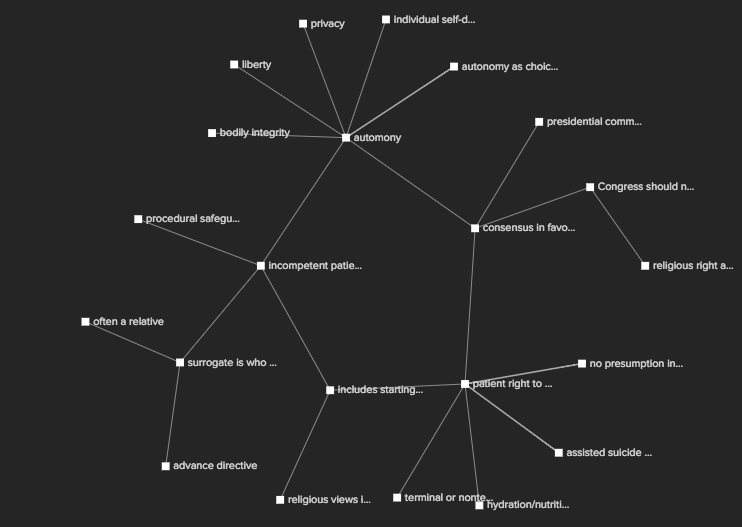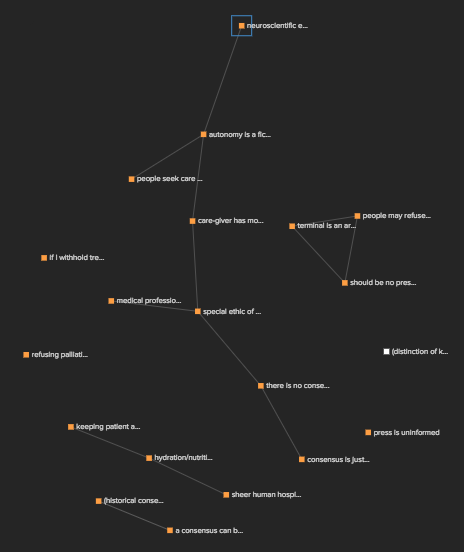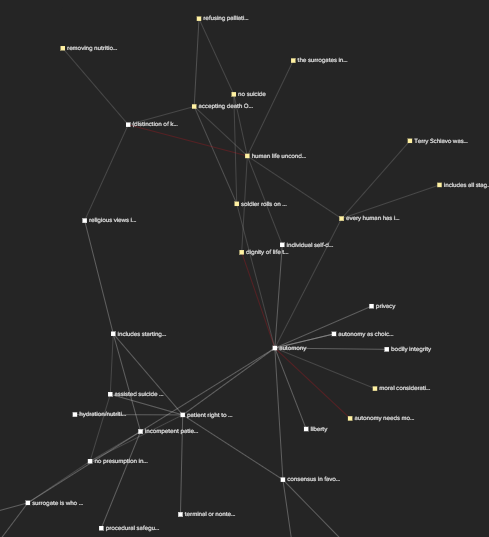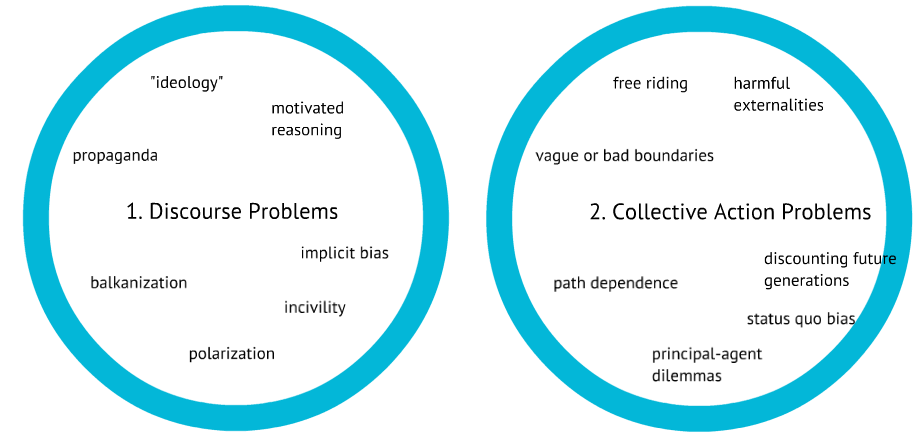Everything is judged
As you walk through the supermarket, your senses absorb data from tens of thousands of objects. Each presents a binary choice: buy or don’t buy. That is a value judgment, even if the only value consideration is whether you happen to like the item’s taste. But most likely, other considerations are relevant as well. Is it healthy? Would your toddler eat it? Is it worth the price, the weight in your basket, and the space on your shelf? And perhaps: were animals harmed in making it? Were people exploited? How much carbon was used to make it? Does the picture on the box objectify the human subject?
You can widen the lens, too, and ask not about individual items on the supermarket shelves but about the supermarket as a whole: Should you be spending your time there? Should your money flow to its owners? Should our systems of production and exchange be organized this way? Who cannot shop here?
And the choices are not really binary: buy or don’t buy. For each object, you could also appreciate it, recommend it, make a note to buy it another time, disparage it, steal it, throw it out the window. You could even act like Allen Ginsberg in “A Supermarket in California” (1955):
I saw you, Walt Whitman, childless, lonely old grubber, poking among the meat in the refrigerator and eyeing the grocery boys.
I hear you asking questions of each: Who killed the pork chops? What price bananas? Are you my angel?
I wondered in and out of the brilliant stacks of cans following you, and followed in my imagination by the store detective.
We strode down the open corridors together in our solitary fancy tasting artichokes, possessing every frozen delicacy, and never passing the cashier.
These lines remind us that we experience more than goods in a store. There are also the other shoppers and workers, real and imagined, alive and dead, with their words and desires. We can walk past anyone or anything without making a judgment; but that, too, is a choice and it implies a judgment.
Everything is structured
It is a familiar observation that experience presents us with too much data, and it all flows together without clear separations in space or time. William James, The Principles of Psychology, 13:
The law is that all things fuse that can fuse, and nothing separates except what must. … The baby, assailed by eyes, ears, nose, skin, and entrails at once, feels it all as one great blooming, buzzing confusion; and to the very end of life, our location of all things in one space is due to the fact that the original extents or bignesses of all the sensations which came to our notice at once, coalesced together into one and the same space.
Therefore, we organize, categorize, simplify, select. We don’t consider each box of Kellogg’s Cornflakes but the whole product line, or perhaps breakfast cereals taken as a class.
Aristotle began the discussion of categories with his book of that name, in which he argued that any thing could be classified in ten ways: where it is, when it is, its relation to other objects, its action, its being acted on, etc. In Kant’s version, the categories were not features of nature but tools of reason—by which he meant not merely human reason, for any animal, angel, or alien would have to use the same tools if it reasoned. Parting with Aristotle and with Kant, we could instead attribute these categories to human psychology (treating them as phenomena of our evolved, physical brains) or of language, which has a deep structure shared by all human beings.
But what matters most to moral judgment in a supermarket are not these fundamentals of location, duration, action, etc., but a more evident type of classification. Objects in a store are for sale or not, expensive or not, healthy or not. Such categories are not features of nature, reason, psychology, or the deep structure of language. They are constructed. Objects in a store have been designed and labeled so that they fit in various categories, for reasons determined by their owners and influenced by governments. Even the people wear various kinds of labels that intentionally classify them. The building as a whole also has marked boundaries and a location on an organized street plan. Although these categories have been constructed, no one controls them completely, for nature intrudes (an object isn’t healthy just because someone says it is) and because each observer has some individuality. I may think a given product is desirable even if you do not.
Some of these categorizations are morally neutral or unexceptional. Some are helpful. But some may be unethical or even evil: for instance, if they encourage us to buy products that gradually kill us or that have required murder and expropriation to create. The typical object is not actually lethal but it does have bad as well as good features. The same is true of each socially constructed category of objects, such as all the breakfast cereals or all the vegan items. And it is true of each institution that has constructed and maintained these categories.
But how can we tell how to judge right? From early school days, we are taught to distinguish between facts, which can be demonstrated or disproved, and opinions, which belong to the person who holds them. Moral judgments seem more like opinions than facts, hence not demonstrable or disprovable. Some people also argue that science is the only path to truth, and science has nothing to say about which objects are good or bad. There is not one “scientific method,” but many methods that scientists use: observation, measurement, classification, model-building, experimentation. But all scientific methods involve rigorous efforts to insulate the facts—to the greatest degree possible—from the observer’s value-judgments.
Such efforts are necessary because we have affective reactions to objects—positive or negative emotional surges that come faster than articulate thought. Francis Bacon already observed that “human understanding when it has once adopted an opinion (either as being the received opinion or as being agreeable to itself) draws all things else to support and agree with it.” Recent psychology insists that our emotional surges–what we find agreeable or disagreeable–explain the thoughts that follow them. We have a feeling and then we rationalize it with conscious ideas.
Thus we need not worry that we are morally apathetic, but we should worry that we are morally wrong. Consider, for example, the experimental evidence that most White Americans (and not a few African Americans) have immediate negative responses to Black faces. That is an example of a strong affective response that is relevant to such everyday experiences as shopping in a supermarket, where both the real people and some of the images on the goods appear to modern Americans to have racial identities. If, after science sifts out the facts, we are left only with instinctive reactions–including some invidious ones–which we then justify with moralizing rationalizations, we are in deep trouble.
Judgment, too, is structured
Individual moral claims are indeed untrustworthy, whether they are instinctive and inarticulate affective reactions or carefully constructed moral propositions. Taken one at a time, they do appear to be nothing more than opinions. We know that people’s opinions differ, and so we have grounds to be skeptical that any are better than others.
But moral claims do not come alone. We connect each one to others. I favor marriage equality–why? Because gay marriage is like heterosexual marriage. Because people want to love and be loved exclusively and durably. Because marriage tends to benefit the children. These are connections among pairs of ideas. They start to form a network. The network is much more persuasive than any particular idea.
First, the network bridges facts and values. Many of the claims in the previous paragraph are empirical, or partly so. Yet the same sentences that make empirical claims also embed deeply moral concepts.
Second, the network has formal features that cannot be attributed to individual ideas. For example, it is more or less consistent and coherent. Those are the most frequently cited criteria of good moral thought, and I believe they are overrated. (Evil fanatics are often highly consistent.) But we can add other formal criteria: networks of ideas ought to be rich, complex, and dense.
Third, a network permits interaction with other people. If I believe X and you do not, there is not much to discuss. But if I believe X because of Y, and Y because of Z, and Z because it resembles A, there is probably some node or connection in what I’ve said that you can lock onto.
My own structured network of ideas reflects the influences on me so far. If I had been born a gentile German ca. 1900, I probably would have favored Hitler in 1939 (if I had lived that long). Because I was born to an American Jewish father in 1967, it was easy for me to see that Nazism was evil. Still, I was correct in that judgment. The quality of the moral network with which we begin to reason is a matter of luck (“moral luck“). It is up to us, however, whether we test our structured ideas with people differently situated and motivated and revise it accordingly.
The post how judgment is structured appeared first on Peter Levine.




